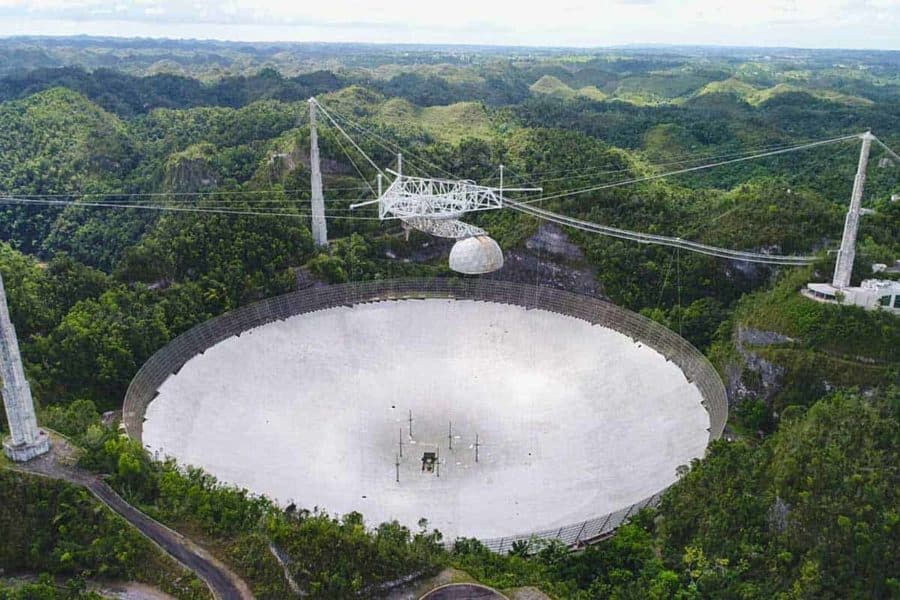A main cable that supports the Arecibo Observatory broke Friday at 7:39 p.m. Puerto Rico time.
Unlike the auxiliary cable that failed at the same facility on Aug. 10, this main cable did not slip out of its socket. It broke and fell onto the reflector dish below, causing additional damage to the dish and other nearby cables. Both cables were connected to the same support tower. No one was hurt, and engineers are already working to determine the best way to stabilize the structure.
A safety zone has been set up around the dish out of an abundance of caution and only personnel needed to respond to the incident are allowed onsite.
Officials haven’t determined why the main cable broke, but they suspect it is related to the extra load the remaining cables have been carrying since August. A monitoring team has been closely watching all the cables and platform since then as part of the facility’s safety and temporary emergency repair plan. Observers had noted and were tracking broken wires on the main cable that failed Friday. The facility was awaiting a team of engineers this week who were expected to begin temporary emergency repairs related to the August incident.
“This is certainly not what we wanted to see, but the important thing is that no one got hurt,” said Francisco Cordova, the director of the observatory. “We have been thoughtful in our evaluation and prioritized safety in planning for repairs that were supposed to begin Tuesday. Now this. There is much uncertainty until we can stabilize the structure. It has our full attention. We are evaluating the situation with our experts and hope to have more to share soon.”
The University of Central Florida, which manages the facility under a cooperative agreement with Universidad Ana G. Méndez and Yang Enterprises Inc. for the U.S. National Science Foundation, worked overnight with the engineering firms WSP, Thornton Tomasetti and Wiss, Janney, Elstner Associates Inc. to come up with a strategy to address the new break. UCF retained these firms in September in connection with the first cable. UCF also notified NSF, which owns the facility and NASA. Drones and cameras are also being used to continue to monitor the structure.
The team hopes to be able to reduce the tension in the existing cables at the tower and install steel reinforcements to temporarily alleviate some of the additional load that is being distributed among the remaining cables. Experts are being mobilized to do the work as quickly as possible. The team will attempt to expedite the arrival of two new cables that were already on order. That’s the current plan pending further evaluation, which will be taking place over the next few days.
UCF has a supplemental funding request pending with the NSF to make temporary repairs related to the original break. There is no cost estimate for the new repairs that will be needed at this time.
Since the August incident, engineers have been working to determine the cause of the initial failure and to create temporary and long-term repair plans. Because there was no obvious cause for the break, the complexities of such a large and unique structure that was built in the 1960s, and the need to prioritize safety above all else, the development of a temporary emergency repair plan has taken some time. Implementation of the first repairs was scheduled to begin this coming week. For more on work being conducted related to the first break click here.
“This is not good, but we remain committed to getting the facility back online,” Cordova said. “It’s just too important of a tool for the advancement of science.”
The Arecibo Observatory is home to one of the most powerful telescopes on the planet. Its instruments are used by scientists around the world to conduct research in the areas of atmospheric sciences, planetary sciences, radio astronomy and radar astronomy. Arecibo is also home to a team that runs the Planetary Radar Project supported by NASA’s Near-Earth Object Observations Program in NASA’s Planetary Defense Coordination Office through a grant awarded to UCF.
Although the facility has suspended most of its operations since the August incident, researchers continue to use data already collected by Arecibo to push ahead with their research. The facility has endured many hurricanes, tropical storms and earthquakes since it was built more than 50 years ago. Through it all, the facility has continued to contribute to significant breakthroughs in space research in the area of gravitational waves, asteroid characterization, planetary exploration and more.


